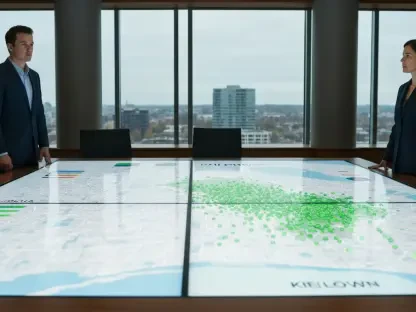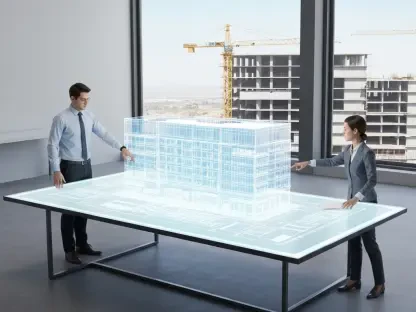The rental housing landscape in Leeds is undergoing a profound transformation, driven by an acute shortage of quality homes in urban centers and a growing demand for modern, flexible living options that cater to diverse needs. With over 20% of the city’s population renting privately, the pressure to deliver innovative solutions has never been higher, especially in regeneration areas like South Bank. This dynamic environment sets the stage for groundbreaking developments that not only address housing needs but also reshape community living standards. Enter Sweetfields, a flagship Build to Rent (BTR) project that promises to redefine rental experiences through cutting-edge design and sustainability.
The BTR sector across the UK has emerged as a critical response to urban housing challenges, offering professionally managed rental properties tailored to contemporary lifestyles. In Leeds, this model is gaining traction as a way to bridge the gap between demand and supply while revitalizing neglected districts. Sweetfields, spearheaded by PLATFORM_ in collaboration with Housing Growth Partnership (HGP), stands at the forefront of this movement, delivering high-quality homes alongside community-focused amenities in a city hungry for change.
This report dives into how Sweetfields is setting new benchmarks for rental living in Leeds, exploring its innovative features, sustainability efforts, and broader impact on urban regeneration. By examining the project’s role within the evolving BTR industry, the analysis highlights trends, challenges, and future prospects that could shape housing strategies in the region for years to come.
The Build to Rent Revolution and Sweetfields’ Strategic Position
The Build to Rent sector in the UK has seen remarkable growth, fueled by urbanization and shifting renter preferences toward professionally managed, amenity-rich properties. This model addresses chronic housing shortages by providing purpose-built rental homes, often in strategic urban locations, as an alternative to traditional homeownership or fragmented private rentals. In Leeds, where population growth continues to outpace housing delivery, BTR projects are becoming vital to meeting demand while supporting city-wide regeneration goals.
Sweetfields, located in the South Bank Regeneration area, exemplifies this trend with its ambitious first phase of 451 homes, part of a larger plan for 1,350 apartments across multiple buildings. Developed by PLATFORM_ and backed by HGP, with construction led by Winvic Construction, the project represents a collaborative effort to transform a key district into a vibrant residential hub. Its strategic positioning near transport links and employment centers enhances its appeal to a diverse renter base seeking convenience and connectivity.
Beyond sheer numbers, Sweetfields underscores the value of professionally managed rental housing in catering to modern needs, such as flexibility and quality of life. By integrating into Leeds’ broader urban renewal plans, the development not only provides homes but also contributes to the revitalization of South Bank, aligning with the city’s vision for sustainable growth through partnerships with local stakeholders like Leeds Council.
Transforming Rental Experiences Through Design and Innovation
Modern Amenities for Diverse Lifestyles
Sweetfields is designed to meet the varied needs of today’s renters, offering a mix of studios, one-, two-, and three-bedroom apartments that cater to singles, couples, and families alike. This diversity ensures accessibility across different income levels and life stages, addressing a critical gap in Leeds’ rental market. The focus on creating adaptable living spaces reflects an understanding of the evolving demands for both privacy and community in urban settings.
Beyond the apartments themselves, the development prioritizes resident experience with an array of high-quality amenities. Community spaces, a reinstated local pub known as The Commercial Inn, an Asda Express for daily convenience, and thoughtfully landscaped areas foster a sense of belonging. These features elevate rental living from mere accommodation to a lifestyle choice, setting Sweetfields apart from traditional rental offerings in the city.
Professional management further enhances this experience by ensuring maintenance, security, and resident services are handled seamlessly. Flexible leasing options also allow renters to tailor their living arrangements to personal circumstances, a key draw in a market where adaptability is increasingly valued. This holistic approach positions Sweetfields as a pioneer in reimagining what rental communities can offer.
Sustainability at the Heart of Development
Environmental responsibility is woven into the fabric of Sweetfields, with every apartment targeting an EPC B rating or higher through advanced energy-efficient technologies. Solar panels, air source heat pumps, and green roofs are among the features reducing carbon footprints, aligning with Leeds’ ambitious goal of achieving net zero carbon status by 2038. Such measures not only benefit residents with lower utility costs but also set a precedent for eco-conscious urban planning.
Additional sustainable elements, such as electric vehicle charging points and sustainable urban drainage systems, demonstrate a forward-thinking approach to infrastructure. These initiatives mitigate environmental impact while adapting to modern transportation trends and climate challenges. Sweetfields thus serves as a model for how rental developments can balance growth with ecological stewardship.
By embedding sustainability into its core design, the project contributes to broader industry shifts toward greener building practices. It challenges other developers in Leeds and beyond to prioritize long-term environmental benefits alongside immediate housing solutions, reinforcing the role of BTR in driving systemic change.
Navigating the Complexities of Large-Scale BTR Projects
Delivering a project of Sweetfields’ scale involves significant logistical hurdles, from coordinating construction timelines to managing supply chain disruptions in a densely populated urban area like South Bank. Ensuring structural integrity and timely completion across multiple buildings requires meticulous planning and execution, a task made more daunting by the need to integrate community amenities concurrently. Winvic Construction’s expertise has been pivotal in overcoming these obstacles, maintaining progress despite inherent complexities.
Market-driven challenges also loom large, with fluctuating demand for rental properties and economic uncertainties posing risks to long-term viability. Shifts in renter demographics or financial conditions could impact occupancy rates, necessitating agile responses from developers. PLATFORM_ and its partners have adopted a phased development strategy to mitigate such risks, allowing for adjustments based on real-time market feedback while scaling up incrementally.
Community integration presents another layer of difficulty, as large projects must balance resident influx with local dynamics to avoid tension. Sweetfields addresses this through proactive engagement, such as public consultations and initiatives to support local employment, ensuring the development enhances rather than disrupts the existing fabric of South Bank. These strategies highlight a commitment to sustainable growth that extends beyond bricks and mortar.
Community Contributions and Regulatory Harmony
Sweetfields plays a transformative role in South Bank’s regeneration, creating tangible benefits for the local area through economic and social initiatives. The project has employed over 100 local workers, alongside apprentices and students, fostering skill development and job opportunities. Programs like Standing Tall, which supports employment for homeless individuals, further amplify its social impact, embedding a sense of responsibility into the development process.
Compliance with local and national housing standards is another cornerstone of the project, particularly in sustainability and urban development policies. Sweetfields adheres to rigorous regulations, ensuring its energy-efficient designs and low-carbon features align with Leeds’ environmental targets. This alignment not only validates the project’s credibility but also strengthens its position as a partner in the city’s broader housing delivery objectives.
Strategic collaborations with Leeds Council have bolstered these efforts, facilitating initiatives like tree planting and local charity support. By contributing to both housing supply and community vitality, Sweetfields demonstrates how BTR projects can serve as catalysts for holistic urban improvement, reinforcing the importance of regulatory and civic synergy in achieving lasting change.
Looking Ahead to Sweetfields and BTR Growth in Leeds
The next chapter for Sweetfields promises further expansion, with Phase 2 set to deliver an additional 540 homes across two buildings by 2027. Enhanced amenities, including gyms and lounge spaces, will build on the foundation of the first phase, enriching the resident experience. This planned growth signals confidence in the project’s model and its ability to meet ongoing demand for quality rental options in Leeds.
Broader trends in the BTR sector point to increasing interest in sustainable, community-oriented developments, with renters prioritizing eco-friendly features and integrated living environments. Technological advancements, such as smart property management systems, are also likely to shape future projects, streamlining operations and enhancing tenant satisfaction. Sweetfields is well-placed to adopt these innovations, maintaining its edge in a competitive market.
The project’s influence could extend to other BTR developments in Leeds, inspiring similar initiatives as consumer preferences evolve and local policies continue to support urban regeneration. Economic conditions and renter behavior will play critical roles in this trajectory, but Sweetfields’ emphasis on adaptability and partnerships offers a robust framework for navigating uncertainties, potentially shaping the city’s rental landscape for the long term.
Reflecting on a Milestone in Rental Housing
Looking back, Sweetfields marked a significant turning point in Leeds’ approach to rental living, blending innovative design with a deep commitment to sustainability and community engagement. Its impact went beyond providing homes, as it revitalized South Bank and aligned with the city’s environmental ambitions through thoughtful planning and execution. The collaboration among PLATFORM_, HGP, and Winvic Construction proved instrumental in overcoming challenges and delivering a model that resonated with modern renters.
Moving forward, stakeholders in the BTR sector should consider replicating Sweetfields’ focus on phased growth and local integration to ensure projects remain responsive to market needs. Investing in sustainable technologies and fostering partnerships with civic bodies could further amplify the success of similar developments. As Leeds continues to grow, embracing such strategies will be essential to addressing housing shortages while building communities that thrive for generations.









